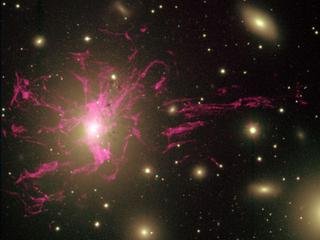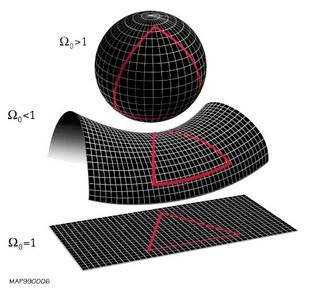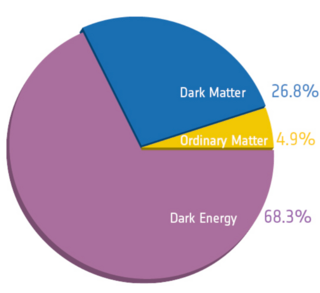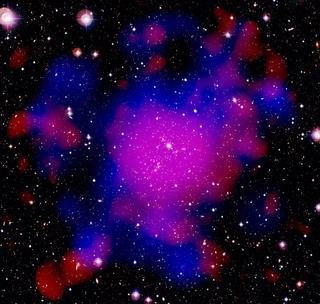Observation of the missing mass of the universe [No, this is not about dark matter]
In my last post on dark matter, there were a few interesting comments asking questions not only on the post, but also on particle and astroparticle physics in greater generalities. One of these questions was in particular referring to two articles available here and there.
These articles are addressing the observation of the missing visible mass of the universe. The results of these two articles are crucial for standard cosmology, which is a fact I did not know before reading them.

[image credits: APOD @ NASA]
This blog post contains a first part defining what we call standard cosmology, before that it moves on with the topic of the two articles that we are after.
To put nice things in perspectives, the key element for the missing visible mass of the universe consists of the kind of red/purple web shown on the picture on the left.
To know what it is exactly, please read this blog post ;)
A FLAT UNIVERSE
The cosmological scenario that is currently considered as standard is named the ΛCDM model, that is an acronym for the Lambda-Cold-Dark-Matter model. The name of the model actually tells us everything about how we think the universe is.
First, the ΛCDM model assumes that the universe is flat (or almost flat). This means that the universe can be seen as a flat surface that is deformed by the objects that are lie it (by virtue of their respective mass).

[image credits: Wikipedia]
This may sound weird, as we know many examples of non-flat things that live in the universe. The key point lies in the definition of flatness.
The easy way to understand that is to start with Earth.
Earth is a curved object (even more precise: it is a sphere). If we are at the equator and draw parallel line towards North, our two lines will cross each other exactly at the North pole.
This is an exemple of the following fact: if two parallel lines cross each other on some surface, this surface is not flat.
That is the definition of flatness that we use when we say that the universe is flat.
Now, let us do the same stuff with the universe and draw two parallel lines pointing to some direction. Our lines will never cross, so that the universe is thus flat. In practice, we can note that there is no need to ‘draw’ lines. We can play with lasers and rays of light.
THE ENERGY PIE OF THE UNIVERSE
After discussing the flatness of the universe, it is interesting to investigate the letters ΛCDM in the name of the standard model of cosmology.

[image credits: ESA]
The Lambda in ΛCDM refers to the cosmological constant, that is written with the Greek letter Λ.
This constant is non zero and it corresponds to the stuff that powers up the currently accelerating expansion of the universe.
Checking the energy budget of the universe illustrated by the pie on the left, this cosmological constant is connected to almost 70% of the energy of the universe. Most of the available energy in the universe is hence used for making the accelerated expansion of the universe possible.
This is also known as dark energy, something that we do not know much about.
The second largest component in this pie concerns dark matter. It amounts to 27% of the energy budget of the universe. In standard cosmology, dark matter is unavoidable. And it helps to get agreement between plethora of predictions and data.
For more information on the dark matter topic, I wrote a lot of blog posts about it. So please have a look! ^^
The third largest component is what is traditionally called visible matter. It includes atoms, or in other words stars and galaxies, as well as neutrinos and photons (whose contribution is tiny).
Visible matter consists of roughly 5% of the energy in the universe, and is what I will talk about during the last part of this blog post.
THE MISSING VISIBLE MASS
What is very important to keep in mind is that all predictions of the flat-ΛCDM model appear to reasonably well agree with data. The model is therefore not ruled out, and lives, safely, very far from the dead theory graveyard…
As said in the previous section, standard cosmology predicts that visible matter only consists of 5 percents of the total energy budget of the universe. That, for instance, stems from indirect data collected, e.g., by the Planck observatory.
However, when one starts evaluating the amount of visible matter (galaxies and stars) in a region of space close to us, we only get about half of what we expect.
The missing component is what is called the missing baryons. This has nothing to do with dark matter. A baryon is indeed a class of particles that we know very well (protons and neutrons are baryons for instance).

[image credits: ESA]
Simulations suggested that the missing mass could hide under the form of filaments of hot gas connecting different cluster of galaxies.
In other words, those filaments are like a kind of web, in which clusters of galaxies would be trapped. Those are the red spots on the picture on the right.
Locating these missing baryons is currently one of the challenge of modern cosmology, to show that all missing baryons are in fact non-missing.
A very strong hint in that direction has just been found last month: the missing baryons seem to be ‘really’ hidden in the filaments of gas connecting the different galaxy clusters.
DISCUSSION AND REFERENCES
Using microwave photons (that are plenty of those in the universe: the cosmic microwave background) and the properties of their scattering processes, two independent research groups managed to show that the gas filaments could actually be where the missing visible mass of the universe was hiding.
This is what the two articles mentioned at the very beginning of this post (here and there) were about.
They manage to use Planck data and the cosmic microwave background photons to evaluate the size of the filaments. They have shown (within the error bars) that they were entirely compatible with the amount of missing mass.
There thus seems to be no more missing visible mass in the universe.
For more information, I recommend the reading of the two above mentioned articles, especially the first one. If you want to learn more about standard cosmology, a good reference is this article where both flat and a less common non-flat Lambda-CDM models are discussed.
For more discussion on this topic (or anything related to science), please join us on steemSTEM. SteemSTEM is a community driven project which seeks to promote well written/informative Science Technology Engineering and Mathematics postings on Steemit. More information can be found on the @steemstem blog.
Isnt it obvious that we will never see the other side of the big bang since its photons are travelling at light speed in the other direction?
I have not sure to understand the comment. Could you please be slightly more specific. What is the "side of the big bang"?
The big bang is the center and we were blown in a certain direction, so we can't expect to see light that travelled in the opposite direction.
Tat is correct. There is indeed something called the ;observable universe' for the reason that there is only fraction of the universe that we can actually observe because light travels at a finite speed.
Isn't this stuff far more interesting then the religious theories? ;)
Actually they are both very interesting and so is music and biology and etc. Many mysteries remain to be solved.
Science is very interesting because we are trying to understand the many mysteries of what reality is and find practical applications. Wrong and disproven scientific theories are not as interesting, but many people still have faith in many disproven scientific theories .
Religion is also trying to understand the many mysteries of what reality is and to find practical applications. There are many cases of people who had metal rods inserted by doctors into their arm or leg or elsewhere to help the bone to grow straight after some serious injury, but when they are lovenly prayed for the metal disappeared and only normal healed bone remained. Why would science not be interested in that? There are many questions. Why does this happen sometimes but not other times? What do the successful praying people have in common? Is there really a Holy Spirit that can turn metal into bone? Is there really Power and Authority in the name of Jesus Christ? If what the scriptures tell us about Jesus is true, and many atheists who've honestly examined the evidence concluded that it is true and became believers, then it becomes very interesting, life changing and with many mysteries to ponder.
Also the question of life after death is very interesting. There are many cases of people who died, met deceased relatives, met Jesus, felt the incredibly peaceful love of God, learned things they previously didn't know and then returned to life to tell their stories. This is another interesting puzzle that science should seriously investigate, but not much science funding available for it. And scientists could even lose their job and paycheck if they tried.
Mathematical physics has given us much interesting insight as to what reality is, but interpreting the math into a model that is real is very challenging. The simple double slit experiment is a great example of this. The simple math, λ = h/p, is well accepted, but the many scientific models describing it's reality are very imaginative, because only one model correctly describes our actual reality. We just don't know for sure which one is the correct model.
Yes it's very interesting to learn more about the model of our universe that says that 95% of the universe is dark and unknown. If some scientists can figure out how to tap into the massive dark energy or the dark matter wind, if it's really there, we would never run out of energy.
Oops, my reply here got a bit too long. Thanks for the interesting post about the universe and the missing visible matter that was found in gas filaments between galaxies.
What a long comment! That deserves a long comment, but I am unfortunately in a hurry. I apology.
I would like to stree that these theories are also good for the purpose of learning. We learn techniques, options, etc... that could be useful for other domains or for explaining other effects.
I will not comment on the religion part as I am more interested in the physics, where one can start with a mathematical model and build things from there. In other words, trying to understand how the world works in its most inner details from very (kind of) simple and (kind of) elegant principles.
All the rest, I leave it to others. This is also the reason why I will not comment further on religions. You can try to link it to science if you want, but one has to cope with the scientific method. To me, this is where things are blocked. But this is my opinion and everyone has the right to disagree :D
My comment was off topic of your informative post. It was just a reply to the comment posted above. Nobody can be an expert on everything. With the accelerated rate of increase in misinformation, it's hard wade through the fake science and find the true gems of knowledge.
The thought of gas filaments of visible matter stretching between galaxies is fun, kind of like humongous spider webs. Wow, humongous spiders weaving galaxies together forming universes... Since we haven't seen them, they must be Dark.
Introducing right here, right now on steemit, my new Humongous Dark Matter Spider Web Model of the Universe.
Made of Dark Matter and full of Dark Energy.
Weaving galaxies together with their webs of intergalactic gas filaments.
All visible matter might be composed of Humongous Dark Spider Webbing.
Do they have to obey the universal speed limit, c, the speed of light?
What are they catching in their intergalactic webs, Humongous Dark Matter Insects?
(This might be too big for even Stan Lee and the Avengers!)
I think my new model needs a little more work.
And now, back to reality...
Photo credit: pixabay
Dark spiders! And Spider Dark Men :D
At least to me ;)
for me, wisdom is not religion. to follow wisdom, to incorporate it into your life, you find it less stressful, easier to manage, and more successful.
so while discussion of the possibilities of the cosmos might be fun, they are far less practical that actual religious theories, when extracted from the arguments, and put into practice to see what works and what doesn't. then take the pieces of wisdom you find in each, and you will have something far greater than the theory of the cosmos...
I disagree. The goals are not the same, and one should not compare apples to pears (which is what you seem to do, although I am not sure as I am not sure to have fully understood your answer :p )
Theories assuming you use the word as everyday people do as a theory (by which they mean hypothesis), to me people trying to explain the universe through religion seem like "hey, i dont know that that is or how it works... therefore God."
The word theory as a well defined meaning in science. It is a mathematical structure precisely explaining the ensemble of all experimental facts of a given domain that can be used to make predictions and that can be tested. Since this is a post about science, it applies here. The rest is not relevant, IMO.
This is a nice post about cosmological theory, next I would like to hear your opinions on cosmetological theory. The field of cosmetology is a very underappreciated science.
Dark matter lipstick! For getting darker :D
So dark it doesn't even interact with your lips!
It is because of the lips, not the darkness :D
This is deep, and will take a while to digest all..... well written post... thanks for sharing
I think I can only say... please enjoy the digestion :)
It's nice to read post related about science. thanks to you. :)
You are very welcome!
Love it, great post
Thank you!
Very nice, I am a new steemian. Now I would like to express my sincere support. I will vote on all your posts, and you follow me also vote on my post please please .....?
https://steemit.com/@saharukhsk
Believe me, this is not the best way to get followers and supporters... Some people are even downvoting such comments (don't worry, I am not)...
Thank you friend, for your advice.
Thats great information...thanks @lemouth
My pleasure :)